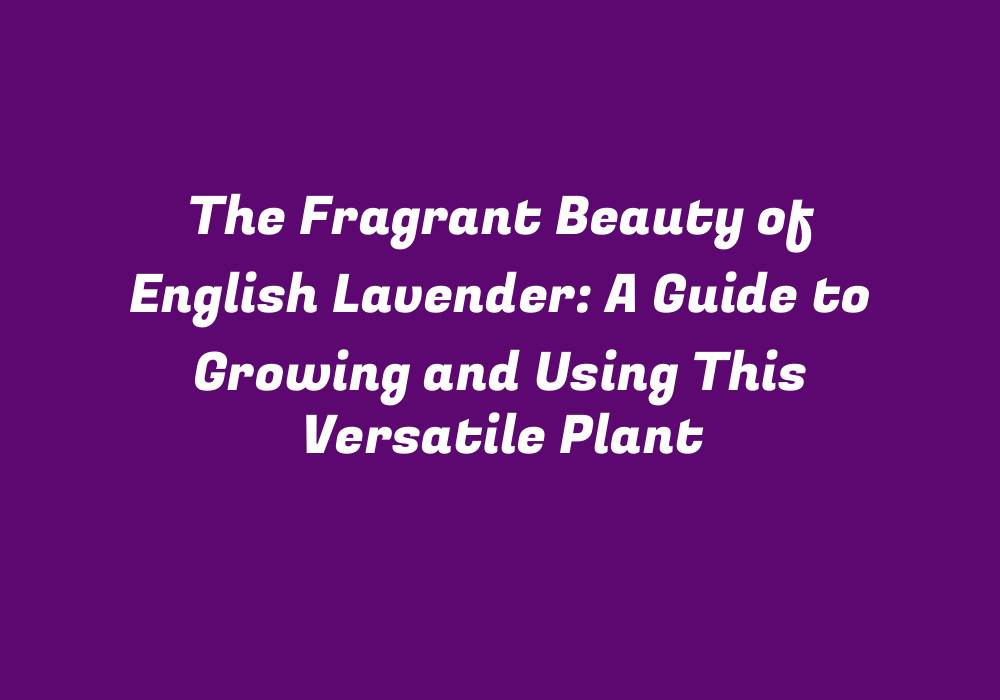Introduction to English Lavender
English Lavender, also known as Common Lavender or Lavandula angustifolia, is a delightful and versatile herb with a rich history of uses in various fields. This fragrant flowering plant can be found in gardens across the world due to its lovely appearance and numerous benefits. From medicinal uses to culinary endeavors, English Lavender has a myriad of applications that make it an essential addition to any gardening enthusiast’s repertoire.
Growing English Lavender
Before we dive into the many uses of English Lavender, let us first discuss its cultivation. This hardy plant thrives best in well-drained soil and full sunlight conditions. To ensure a successful harvest, consider these key factors when growing your own English Lavender:
Soil Preparation
English Lavender prefers slightly alkaline to neutral soil, with a pH range of 6.5-7.5. It is essential to amend the soil with plenty of organic matter and lime to achieve this ideal pH level. Dig holes that are twice as wide as your root balls for proper drainage, which will also aid in preventing root rot. Avoid using freshly manured or heavily fertilized soils, as these may inhibit growth.
Planting and Spacing
When planting English Lavender, consider spacing the plants appropriately to give them enough room to grow. Generally, it is recommended to space them 12-24 inches apart, depending on their variety. It is also essential to ensure proper air circulation and avoid overcrowding, which can lead to increased susceptibility to diseases.
Watering and Fertilization
English Lavender is quite drought-tolerant once established. However, it is crucial to water them regularly during the first growing season for optimal growth. During dry periods or in regions with sandy soils, supplemental watering may be necessary. English Lavender doesn’t require excessive fertilization, but an application of compost annually can support its health and vigor.
Pruning and Maintenance
Regular pruning is essential to maintain the desired shape and promote healthy growth. Prune English Lavender in late summer or early fall to encourage new growth for a more vibrant display during the following season. Additionally, remove any dead, weak, or damaged stems to encourage better air circulation and prevent potential pest infestations.
Pests and Diseases
English Lavender is generally resistant to pests and diseases. However, it may attract aphids, spider mites, or whiteflies in some cases. Regularly inspect your plants for any signs of infestation and treat them accordingly with natural insecticides or soap solutions if necessary. If your lavender shows signs of yellowing leaves, consider testing the soil pH to ensure it is within the recommended range.
Using English Lavender
Medicinal Uses
English Lavender has been used for centuries in herbal medicine due to its soothing, anti-inflammatory, and antiseptic properties. The essential oil extracted from the plant can be applied topically or inhaled to alleviate headaches, stress, anxiety, and sleep disorders. It is also known to promote wound healing and offer relief for respiratory issues.
Culinary Applications
English Lavender’s delightful fragrance and floral flavor make it an excellent addition to various culinary creations, such as teas, desserts, and savory dishes. The lavender buds can be used to create unique and aromatic recipes, while the essential oil adds a delicate touch when infused in oils, vinegars, or honey. It’s important to use English Lavender with caution in cooking, however, as it has a strong flavor that can overpower other ingredients if not used sparingly.
Aromatherapy and Scented Products
The fragrance of English Lavender is beloved for its calming, relaxing qualities. It can be used to create soothing lavender-infused sachets or potpourri mixtures, as well as natural essential oil diffusers. The plant’s essential oil can also be added to bath salts, lotions, and massage oils for a truly indulgent experience.
Gardening Applications
English Lavender is an ideal companion plant in gardens due to its insect-repelling properties. It naturally deters pests like aphids and moths, making it a valuable addition when growing other plants susceptible to these issues. Additionally, English Lavender’s stunning blooms make it an attractive choice for decorative landscaping or as a border plant.
Crafts and Decorations
The beauty of English Lavender extends beyond its many uses in gardens, culinary endeavors, and wellness applications. Its blooms can be used to create lovely floral arrangements or dried for use in wreaths and other decorative items. The lavender stems themselves can also serve as a base for elegant centerpieces or bouquets.
In conclusion, English Lavender is an exceptional plant with countless uses and benefits that make it a must-have in any garden or home. By following the necessary steps to grow this fragrant beauty successfully and utilizing its versatile nature in various applications, you can experience firsthand the delightful charms of this remarkable plant.
